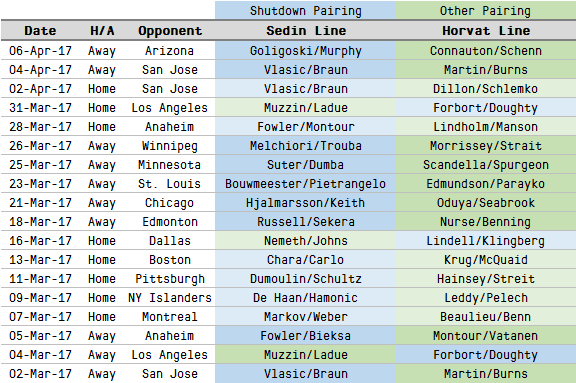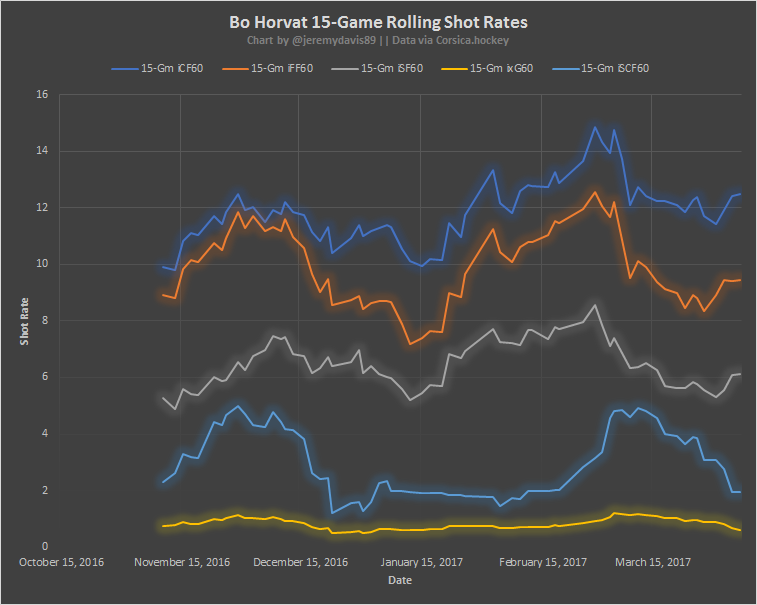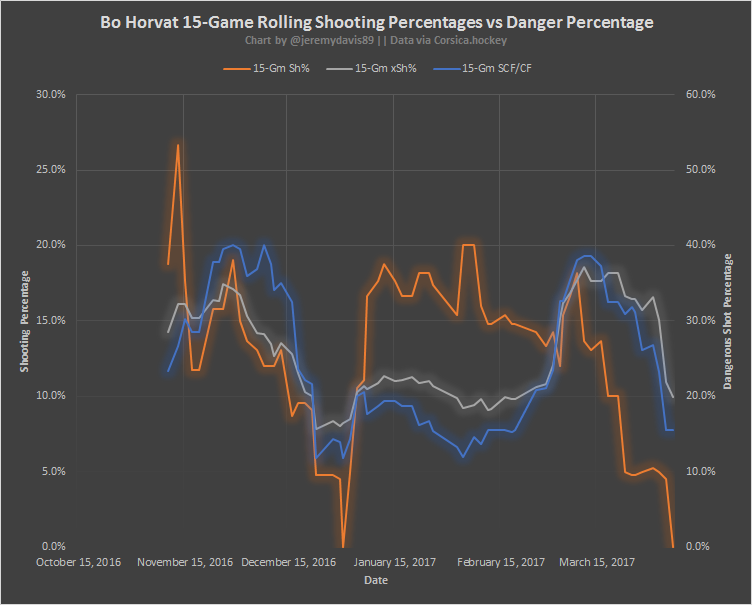Is Bo Horvat Being Shut Down By Opponents’ Top Pairings?

By Jeremy Davis
7 years agoAs the Canucks season has worn on, the decline of the Sedins has become an undeniable reality, while the rise of Bo Horvat has lessened the blow ever so slightly. While I pointed out in December that Bo Horvat had already been producing at the rate of a top line forward for quite some time, other teams has not been treating him as such – something that could have contributed to his ability to lead the team in points.
That transition from providing scoring depth to be the relied-upon producer hasn’t been easy on Horvat. He’s now gone 15 games without scoring a goal, and his points are few and far between (he has six assists during his goal drought), despite a noticeable uptick in ice time.
The assumption has been that Horvat’s slump is tied to opposing teams catching on and defending Horvat with their premier shutdown players. So how much of this can be blamed on opponents treating him like the Canucks’ most dangerous forward, and how much can be blamed on other factors?
Facing Top Defenders
This has been a topic in Vancouver for some time now, as fans, analysts, and even the coaching staff have been talking about how Horvat would handle facing the other team’s top defensive pairing, now that we in Vancouver have decided that he has surpassed the Sedins. While it’s been discussed in Vancouver that Horvat is struggling against shutdown pairings, cursory glances at nightly shared ice times with competition haven’t born this theory out, so I’ve decided to look at it in greater detail, and determine with some finality how teams are deploying their defenders against the Canucks.
To assess how other teams are defending the Canucks’ forward lines, we’ll look mostly at Vancouver’s away games – with the home team having last change, we can easily see how the opposing coach has chosen to defend Vancouver’s various line combinations.
For the purposes of this study, we’ll have to determine which opposing defensive pair is considered the “match up” or “shutdown” pair. For that, I’ll use Corsica’s TOI% (the percentage of 5-on-5 ice time that the defenceman plays) and their TOI.QoC metric, which assigns a value based on the average 5-on-5 TOI of a given player’s on-ice competition to see who they are frequently playing against. For the less clear cut cases, I’ll also examine how the pairings were deployed against other teams’ star forwards in nearby games.
I’ve colour coordinated the pairings, with blue representing the shutdown pairing, and green representing any other pairing. The away games are darker, since they are more significant for the reason given above.
Here are the results:

This chart gives a pretty strong indication that most teams are still treating the Sedins as the Canucks’ top line. In the 18 games since the trade deadline, only Dallas and Los Angeles (twice) have focused their shutdown defencemen on Horvat’s line. Even then, there’s a caveat: Los Angeles’ top two shutdown defencemen, Drew Doughty and Jake Muzzin, were split, with Muzzin covering the Sedins, while Doughty covered Horvat. Doughty trumps Muzzin in the metrics I was using to determine the shutdown defencemen, so Doughty’s pairing gets the blue treatment.
Of further note is the fact that in some games, the opposing team wasn’t even treating Horvat like the second line, instead covering him most often with their bottom pairing while the middle pairing was tasked with covering Brandon Sutter’s line. The March 18th game against Edmonton, and the April 6th game against Arizona are two such examples.
There is a further, more unsettling implication of this information: Horvat’s slump is not due to other teams focusing on shutting him down. Despite the struggles that he is having, he still isn’t having to face top shutdown pairings on most nights. It’s easy to associate Horvat’s slump with having to face harder defensive matchups, but the shift hasn’t been that clean. This is worrisome of course because it means that Horvat still has another level of competition to prove himself against before we can safely anoint him a top line player.
Alternative Explanations
It’s difficult to put a finger on a exactly why Horvat has been struggling to produce at 5-on-5. However, it’s easier to demonstrate the ways in which he is. We’ll start by examining Horvat’s shot rates over the course of the season.
As with all things in hockey, there have been ebbs and flows in the rate at which Horvat has been sending the puck in the direction of the opposing net over time. His shot rate peaked pretty much across the board rate around the trade deadline – oddly enough, the February 28th game immediately preceding the deadline coincided with his highest 15-game average in individual Corsi, Fenwick and Shots on Net per 60 minutes.
Since then, his shot rates have been in steep decline, as noted by the following graph displaying 15-game rolling rates of individual Corsi (all shots), Fenwick (unblocked shots), Shots on Goal, Scoring Chances, and Expected Goals:

There are two things that jumped out at me here: one is that the decline in his Scoring Chance rate is steeper (relative to its peak) than any other classification of shot; the other is that while his shot, unblocked shot, and shots on net rates have rebounded in the past few games, his scoring chance rate has not.
I wrote a post on my own website, OneCanuck, which has regrettably since gone dark, back at the tail end of Horvat’s rookie season detailing how I felt he could regularly maintain a higher than average shooting percentage because a high percentage of his shots were coming from within dangerous areas. Keeping that in mind, take a look at this next graph, plotting Horvat’s rolling shooting percentage and expected shooting percentage against his “dangerous shot percentage”, which is essentially the percentage of all his shots (iCF) that are classified as scoring chances.

The orange line in this graph represents his individual shooting percentage (iSh%). Shooting percentages are naturally subject to a large amount of luck, given the low volume of 5-on-5 goals scored by individuals in any given season. You can see in the graph that Horvat’s shooting percentage has gone in the tank, and has recently landed at zero. This is of no surprise, considering that he’s in the midst of a 15-game goal drought.
The grey line represents his expected shooting percentage, which is the same idea but using expected goals instead of actual goals. Using expected goals allows us to see how often he should be scoring, given where he is shooting from, as well as his historical shooting percentage and the goaltender’s historical save percentage. As an aside, the difference between shooting percentage and expected shooting percentage is a far better indicator of player “puck luck” than the oft-referenced PDO.
What I really want to draw your attention to is the blue line – which represents Horvat’s dangerous shot percentage – and more specifically, how eerily it matches up with the expected shooting percentage. Again, this is somewhat intuitive. After all, expected goals are going to increase as more shots are taken from high percentage areas, the same logic that drives increases in dangerous shot percentages.
After all of this data driven rambling, we finally come to some semblance of a conclusion: Bo Horvat is not getting enough shots off from high percentage areas.
This too, however, is as much a symptom of something more discreet as it is a cause of his scoring problems. The question becomes, why has his rate of scoring chances decreased so sharply since the trade deadline?
I don’t have any concrete answers, but I do have a couple of theories that I will share.
One would involve the general malaise around the team since that point. The deadline, while celebrated by fans, signaled on some level that management had given up on the season – and rightfully so, the team was well out of a playoff spot. It might be going to far to say that the team isn’t trying as hard since then (although it certainly looks it on some nights), and I certainly wouldn’t accuse Horvat of taking his foot off the gas, but the weight of a lost season overflowing with negativity and hopelessness could certainly be taking its toll.
A more tangible change is the physical loss of those players at the deadline. Shortly before being dealt to contending teams, both Alex Burrows and Jannik Hansen had been playing with Horvat – Burrows for much of the season and Hansen mostly in the absence of Sven Baertschi, sidelined with a concussion.
Horvat, Baertschi and Burrows spent 373 minutes at 5-on-5 together this since, while Horvat and Burrows spent an additional 67 minutes since Hansen. All told, Horvat potted seven 5-on-5 goals with Burrows on the ice, and an additional nine assists.
His point rate with Burrows was higher than his point rate without Burrows, but not greatly so. Burrows provided another major benefit to Horvat: his defensive acumen and transitional play allowed Horvat to spend significantly less time in his own end, and more time scoring goals.

This Corsica With-or-Without-You chart demonstrates that, in many cases, Horvat’s linemates fared better away from him than with him. That could probably be partially explained by Sven Baertschi, who has had dreadful results this season without Horvat. The numbers would indicate that Baertschi is bringing Horvat’s shot shares down in some cases, though the data is not conclusive.
The Burrows set is interesting, as it appears that the combination of Horvat and Burrows was greater than the sum of their parts – they were able to work magic together despite having relatively uninspiring numbers on their own.
Horvat has suffered in plenty of other ways away from Burrows: his on-ice Goals For rate is down, his Goals Against rate is up, his on-ice and personal shooting percentages are down. While the line of Horvat, Baertschi and Brock Boeser has looked good, and has been somewhat dominant possession-wise, the benefits have yet to manifest themselves in Horvat’s personal scoring data.
Summary
There is no doubt that Horvat has been in a funk, and it’s pretty clear that things have been trending down for him since the trade deadline. Unfortunately, it’s not an increase in focus from the other team that is causing the problem, as Vancouver’s opponents have for the most part continued to play their top shutdown defencemen against the Sedins. That’s bad news, considering it means he still has even more potential roadblocks ahead.
His problems are stemming from an inability to get shots off from high percentage areas, though the reasoning for that is a little murky. The absence of Alex Burrows has certainly had an effect, and though the addition of Brock Boeser has brought a return of strong possession play, it hasn’t brought a return to goals for the presumptive future captain.
We should feel fairly comfortable in assuming that the current combination of lines will allow Horvat to break his slump, given enough time. The unfortunate reality is that there isn’t much time remaining. There are only two games remaining in the Canucks’ 2016-17 season, and even with solid play there are no guarantees that he’ll find the twine before the end of the season, and a 17-game goalless drought is probably not how Horvat wants to finish his first campaign as the Canucks’ leading scorer and face of the future.
Recent articles from Jeremy Davis





